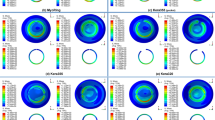Abstract
The aim of this study was to qualitatively evaluate the biomechanical load resistance of different surgical wound configurations (mushroom, zig-zag, anvil and conventional trephination) in penetrating keratoplasty (PK) by designing a 2D and a 3D finite-element biomechanical model of the cornea. A mathematical model of the human cornea was developed, and different geometric configurations for PK were designed. The internal pressure was raised until the wound misaligned; wound prolapse then occurred. Better wound resistance was found in all the laser trephined profiles tested in comparison with the conventional straight one. The anvil profile was more resistant to the increasing internal pressure than was the mushroom or the zig-zag pattern. Thanks to its greater mechanical load resistance, the anvil profile made possible the apposition of a restricted number of sutures and early suture removal. These advantages can contribute to a faster visual recovery in patients undergoing penetrating keratoplasty.










Similar content being viewed by others
References
Bahar I, Kaiserman I, McAllum P, Rootman D (2008) Femtosecond laser-assisted penetrating keratoplasty: stability evaluation of different wound configurations. Cornea 27:209 11
Busin M, Arffa RC (2005) Microkeratome-assisted mushroom keratoplasty with minimal endothelial replacement. Am J Ophthalmol 140:138–40
Cabrera Fernndez D, Niazy AM, Kurtz RM, Djotyan GP, Juhasz T (2005) Finite element analysis applied to cornea reshaping. J Biomed Opt 10:064018
Canovetti A, Malandrini A, Lenzetti I, Rossi F, Pini R, Menabuoni L (2014) Laser-assisted penetrating keratoplasty: 1-year results in patients using a laser-welded anvil-profiled graft. Am J Ophthalmol 158:664–670
Chamberlain WD, Rush SW, Mathers WD, Cabezas M, Fraunfelder FW (2011) Comparison of femtosecond laser-assisted keratoplasty versus conventional penetrating keratoplasty. Ophthalmology 118:486–91
Farid M, Kim M, Steinert RF (2007) Results of penetrating keratoplasty performed with a femtosecond laser zigzag incision initial report. Ophthalmology 114:2208–2212
Gaster RN, Dumitrascu O, Rabinowitz YS (2012) Penetrating keratoplasty using femtosecond laser-enabled keratoplasty with zig-zag incisions versus a mechanical trephine in patients with keratoconus. Br J Ophthalmol 969:1195–9
Ignacio TS, Nguyen TB, Chuck RS, Kurtz RM, Sarayba MA (2006) Top hat wound configuration for penetrating keratoplasty using the femtosecond laser: a laboratory model. Cornea 25:33640
Kim JH, Choi SK, Lee D (2009) The comparison of femtosecond laser-assisted penetrating keratoplasty with conventional surgery in terms of endothelial safety: ex vivo study using porcine eyes. Cornea 28:812 6
Kook D, Derhartunian V, Bug R, Kohnen T (2009) Top-hat shaped corneal trephination for penetrating keratoplasty using the femtosecond laser: a histomorphological study. Cornea 28:795 800
Lee HP, Zhuang H (2012) Biomechanical study on the edge shapes for penetrating keratoplasty. Comput Methods Biomech Biomed Eng 15:1071–79. Phthalmol, 143, 689691 (2007)
Malta JB, Soong HK, Shtein R, Banitt M, Musch DC, Sugar A, Mian SI (2009) Femtosecond laser assisted keratoplasty: laboratory studies in eye bank eyes. Curr Eye Res 34:18 25
Menabuoni L, Canovetti A, Rossi F, Malandrini A, Lenzetti I, Pini R (2013) The ’anvil’ profile in femtosecond laser-assisted penetrating keratoplasty. Acta Ophthalmol 91:e494–5
Nassar GA, Arfeen SAES (2017) Correlation between the graft-host junction of penetrating keratoplasty by anterior segment-optical coherence tomography and the magnitude of postoperative astigmatism. Indian J Ophthalmol 65:574–8
Nuzzo V, Aptel F, Savoldelli M, Plamann K, Peyrot D, Deloison F, Donate D, Legeais JM (2009) Histologic and ultrastructural characterization of corneal femtosecond laser trephination. Cornea 28:908–13
Pandol A, Manganiello F (2006) A model for the human cornea: constitutive formulation and numerical analysis. Biomech Model Mechanobiol 5:23746
Pini R, Rossi F, Ratto F (2011) Laser surgery. In: Popp J, Tuchin VV, Chiou A, Heinemann SH (eds) Handbook of biophotonics. Wiley, New York, pp 911–937
Price FW Jr, Price MO (2008) Femtosecond laser-shaped penetrating keratoplasty: one-year results utilizing a top-hat configuration. Am J Ophthalmol 145:210–214
Price FW Jr, Price MO, Jordan CS (2008) Safety of incomplete incision patterns in femtosecond laser-assisted penetrating keratoplasty. J Cataract Refract Surg 34:2099–103
Raj A, Dhasmana R, Bahadur H, Nagpal RC (2017) Monitoring the appositions of posterior graft-host junctions with anterior segment optical coherence tomogram after penetrating keratoplasty. Int Ophthalmol 37:357–64
Rossi F, Pini R, Menabuoni L (2007) Experimental and model analysis on the temperature dynamics during diode laser welding of the cornea. J Biomed Opt 12:014031
Rossi F, Matteini P, Ratto F, Menabuoni L, Lenzetti I, Pini R (2010) All laser corneal surgery by combination of femtosecond laser ablation and laser tissue welding. In: Tuchin VV (ed) Handbook of photonics for biomedical science. CRC Press Taylor and Francis Group, Boca Raton, pp 799–810
Steinert RF, Ignacio TS, Sarayba MA (2007) Top-hat shaped penetrating keratoplasty using the femtosecond laser. Am J Ophthalmol 143:689–691
Acknowledgements
The authors wish to thank the LA ROSES experiment of the FP7 ECHORD++ project for partial support of this study and removal of the per cent signs.
Author information
Authors and Affiliations
Corresponding author
Ethics declarations
Conflict of interest
The authors declare no conflict of interest.
Additional information
Publisher's Note
Springer Nature remains neutral with regard to jurisdictional claims in published maps and institutional affiliations.
Rights and permissions
About this article
Cite this article
Canovetti, A., Rossi, F., Rossi, M. et al. Anvil-profiled penetrating keratoplasty: load resistance evaluation. Biomech Model Mechanobiol 18, 319–325 (2019). https://doi.org/10.1007/s10237-018-1083-y
Received:
Accepted:
Published:
Issue Date:
DOI: https://doi.org/10.1007/s10237-018-1083-y




